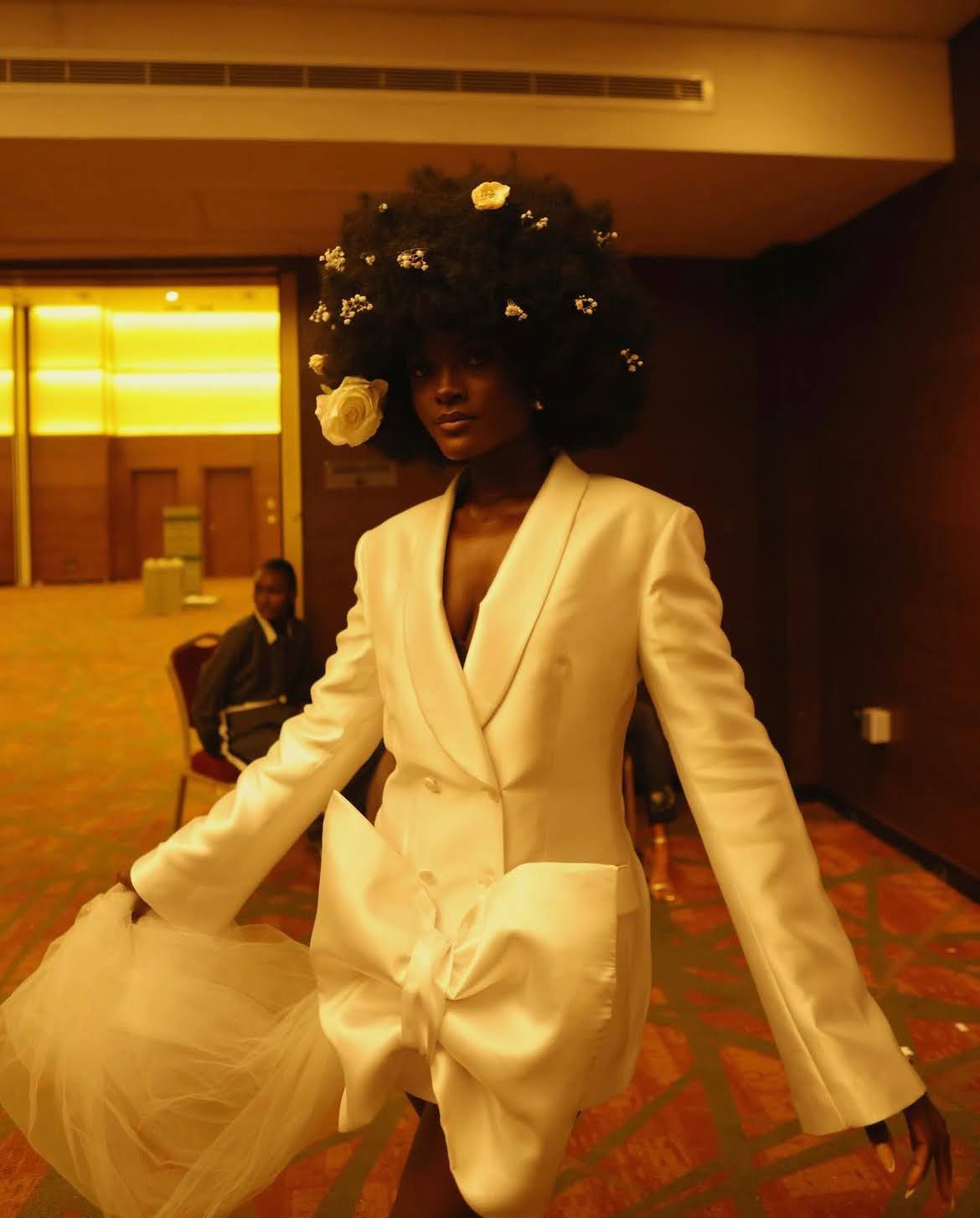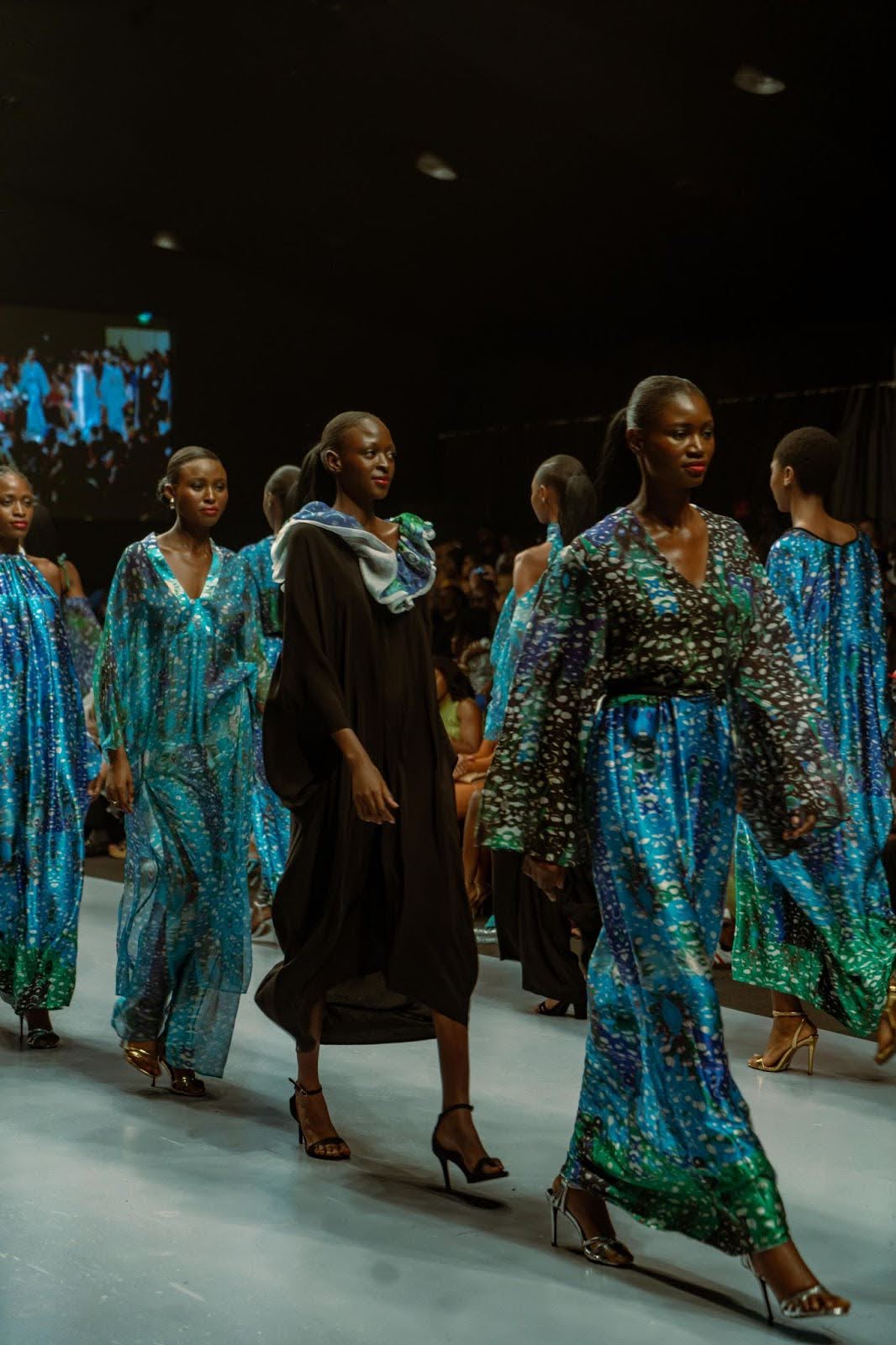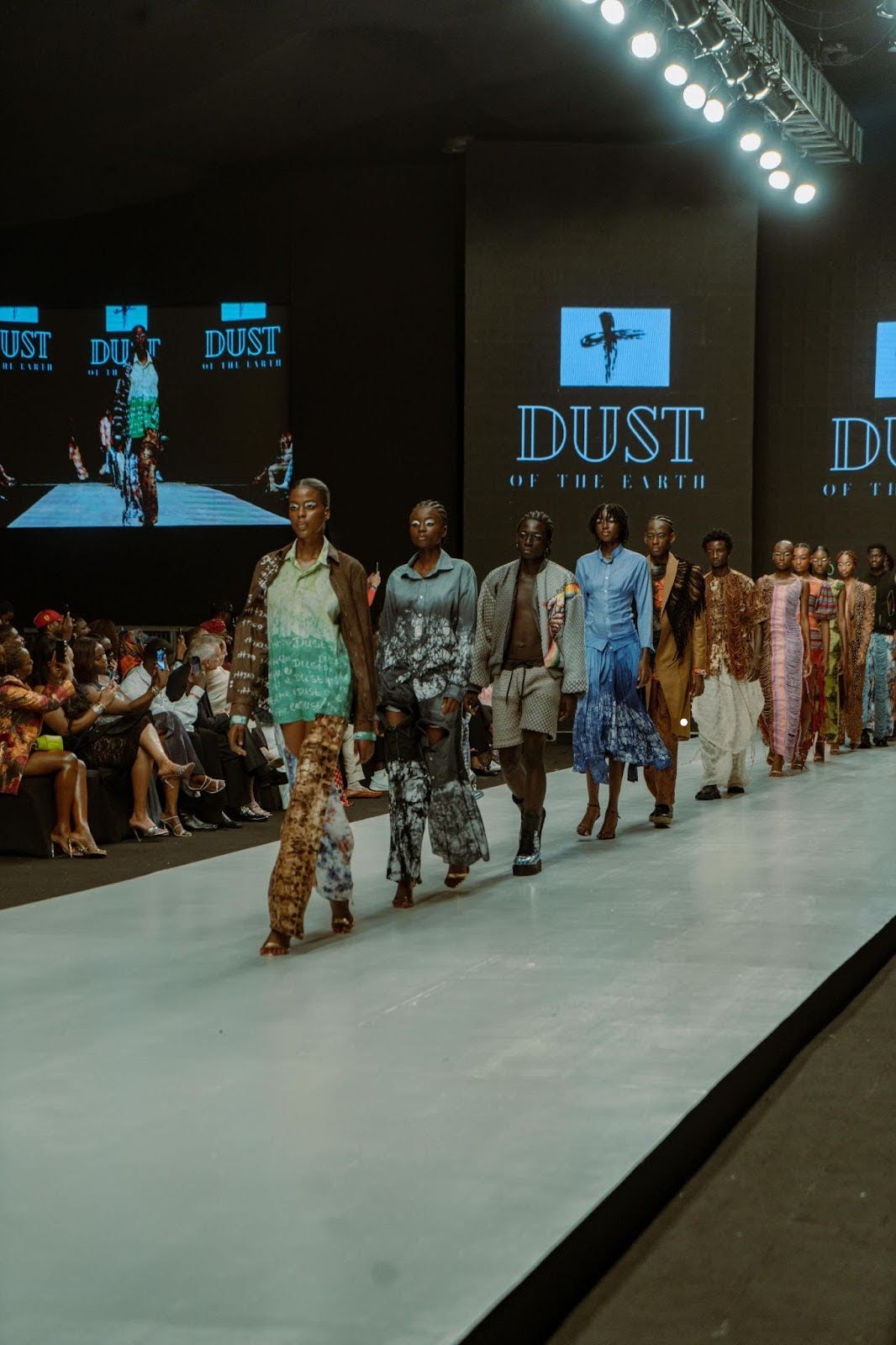A LOOK INSIDE THE INDUSTRY THAT LAGOS FASHION WEEK BUILT
As the fashion industry continues to evolve, Lagos Fashion Week remains a driving force, fostering innovation, creativity, and sustainable practices.
As the fashion industry continues to evolve, Lagos Fashion Week remains a driving force, fostering innovation, creativity, and sustainable practices.
Kaly is a rooftop restaurant and bar lounge overlooking the Eko Atlantic. It is a hub for young adult Lagos-based influencers. However, on October 23, it became the venue for a party celebrating the first day of the Lagos Fashion Week calendar.
It is my third fashion week in Lagos and my favourite part of the show is the models. So when Nigerian supermodel, Rebecca Fabunmi, walks in, I see her and ask, “Are you wearing Lisa Folawiyoo?” She and everyone within a certain radius corrects my horrendous Yoruba, “It is Folawiyo.”
Then it hits me, everyone knows our designers. Our designers are praised and almost everyone at this party is wearing a Nigerian label. During a BBC Radio interview the next day, the host inquired, “If Nigerian fashion is to have a place on the international agenda, is it attracting the money because that is what it is about? And is that money going to support these younger designers?”
IN THE BEGINNING, THERE WAS TEXTILE
This question has troubled the Nigerian industry since the 2000s; how to make the fashion industry a lucrative one. The 2020s perception of Nigerian fashion is a far cry from its 2010s counterpart; back then, there was a stigma about wearing Made In Nigeria clothes that affected both the social and financial efforts made by our established textile industry.
In 2011, New Cloth Market published an article about Nigeria’s dying textile industry. A paragraph in the article states, “In any developed or developing economy, the indices used in judging growth is primarily based on the producing power of that country. Industries form the bulk of these indices. In Nigeria for instance, more than 80% of all finished consumer products are imported. Nigeria relies more on imports while its once vibrant industries are facing near extinction.”
Nigeria’s textile industry was once one of the country’s most vibrant. According to New Cloth Market, it played a pivotal role in stemming the tide of unemployment between the late 1950s and early 1990s. This started in 1956, when Nigeria began to process locally grown cotton, and by the 1970s and 1980s, our textile industry was Africa’s third-largest. This period saw significant growth, with an annual expansion of 67% between 1985 and 1991, employing 25% of the manufacturing workforce in 1991. By the 2000s, rates were abysmal, with the New Cloth market reporting, “Exports of textile products dipped below $11m in 2008 from $44m five years earlier.” Soon, the influx of cheaper textile products from countries like China would further erode the market share of Nigerian textile manufacturers, and the dream of Nigerians wearing home-grown garments as a norm, became more and more distant.
THE MODERN PERCEPTION OF NIGERIA’S FASHION SCENE.
In recent years, Nigerian fashion has experienced a remarkable surge in global popularity, captivating international audiences with its unique blend of traditional African aesthetics and contemporary design sensibilities. Today, the country’s high fashion community boasts household names like Kenneth Ize, Orange Culture, Tolu Coker, Tokyo James, Lagos Space Programme, and many more.

Its high street industry created a movement in Africa with breakout brands like Street Souk (the largest streetwear convention in Africa), WAF, Motherlan, PITH Africa, and many more. Even Nigerian subcultures such as the Alté community are forces to be reckoned with within the country’s fashion scene. In the words of South African fashion Tiktoker, Tanatswa Amisi, “Especially in South Africa, specifically in Johannesburg and the fashion community here, people are inspired by the Alté scene and I don’t even think they realise it.”
Nigeria has also become one to watch out for in the industry with homegrown fashion figures appearing on the Business Of Fashion 500 list over the last ten years. In a discussion with the Kenya entrepreneur, Wandia Gichuru, founder of East Africa’s fastest-growing fashion chain, Vivo, she pays homage to the pace set by Nigerian fashion: “Nigeria’s fashion is ahead and established but here in East Africa, we are getting there. It is beautiful to see how far Nigeria has come.” Gichuru’s statement is reflected in other African countries according to Nigerian head designer for ATAFO, Mai Atafo. Atafo mentioned that he is frequently invited to design outfits for government officials in various countries. “They pay attention, they appreciate what we are doing and it inspires them.”
Nigeria accounted for about 15% of the $31 billion fashion market in Sub-Saharan Africa in 2015, and grew to 17% between 2010 and 2019, as reported by Business Day Nigeria in 2024. Lagos Fashion Week attracts the attention of international publications like Vogue, Dazed, and i-D. Several Nigerian designers have gained global success including Kenneth Ize, Orange Culture, Mowalola, Tolu Coker, and Banke Kuku.

HOW LAGOS FASHION WEEK CHANGED THE GAME:
One can not discuss fashion in Nigeria without mentioning Shade Thomas-Fahm. Born in 1933, she was the first fashion designer to open a fashion boutique, Maison Shade, in Nigeria.
The now 91-year-old Fahm recently sat down with The Guardian’s Life Magazine to discuss how she built her career. During the interview, she noted the difference between modern fashion shows and what they used to be like. “When I came back to Nigeria, I was able to project fashion to the Nigerian people by hosting charity fashion shows,” she explains. She did not profit from the gate fees as they went to charity. Women’s organisations often asked her to create these events to raise funds; similar to Nigerian singer Tems’ annual wardrobe sale in partnership with Women at Risk International Foundation (WARIF).
The modern shows usually act as bridges to connect independent designers with buyers. The most renowned of these shows in Nigeria is Lagos Fashion Week, and it’s also the continent’s largest annual fashion show. Established in 2011 by Omoyemi Akerele, the show set out to bring the Nigerian and African fashion scenes to the global stage, by bringing together media, buyers, manufacturers and consumers. Akerele aimed to excite Nigerians about local fashion and help them see beauty in themselves. She reaffirms, “That is why after 13 years, we still strictly use Nigerian models. We are promoting Nigeria.”
Hazel Eki Osunde, the founder of Eki Silk, has been part of the Lagos Fashion Week family since its inception. “Lagos Fashion Week has had an incredible impact on EKI SILK, significantly elevating the brand’s visibility and credibility in the fashion world,” Osunde explains. “Through this partnership, EKI SILK has had the remarkable opportunity to have collections stocked at Selfridges, a pop-up at Bluebird in the UK, and even a showcase at Clarence House, where King Charles himself hosted an event before embarking on a trip to Africa. Such high-profile exposure would have been challenging to achieve independently.”

Osunde also spoke about the exposure that comes with showcasing at the event. “In addition to these prestigious placements, EKI SILK has gained international media coverage in top-tier publications, including Vogue, Harper’s Bazaar, and the Financial Times.” She has been able to sustain her brand by relying on Lagos Fashion Week to do the heavy lifting when it comes to marketing.
Juilet Olanipekun of LFJ, who debuted at Lagos Fashion Week in 2023, believes that the exposure from the event is unprecedented. “Lagos Fashion Week has been pivotal for us,” she says. “The exposure and media attention have introduced our work to a global audience, and the platform has connected us with buyers, editors, and fashion enthusiasts worldwide. It has not only helped us grow our customer base but also strengthened our connections within the industry, leading to incredible partnerships and collaborations.”
Founder of Dust Of The Earth, Temetan Omolabake, made her debut as a finalist for Lagos Fashion Week’s Green Access Programme in 2023. This year, she returned to its runway as an emerging designer. For her, this was mind-blowing. “Looking back, the experience felt surreal, as though I was still lost in a fantasy world, watching my creation stride confidently down the runway.”

The Green Access Program is a joint initiative by Lagos Fashion Week and Style House Files to promote sustainable fashion. It supports young designers by providing resources and training to focus on eco-friendly practices like using sustainable materials, reducing waste, and creating long-lasting designs.
Akerele has set up products like Woven Threads, Green Access Programme, and XRetail to find and harness the next big brand. This year, she partnered with the global talent incubator Qaisimi Rising to boost newer designers in Nigeria. She has also held several advisory positions at Industrie Africa and Jendaya, and has been an advisor to the MoMA, the Victoria & Albert Museum, the UN, the British Fashion Council and the State of Fashion Netherlands. She takes care of the larger business propels designers to where they need to be.
In the last few years, the Nigerian fashion industry has seen an array of highlights, with 2024 being a banner year for Nigerian fashion, with several groundbreaking achievements. Designers Tolu Coker, Priya Ahluwalia, and Torishéju Dumi graced the cover of British Vogue, a significant milestone for African representation in global fashion, while Tokyo James made waves by taking over Milan Fashion Week, showcasing his designs on the international stage.
Banke Kuku, a visionary designer, captivated audiences with her ocean-themed fashion show, a stunning collaboration with renowned brands like Mikano Motors, MAC Cosmetics, and Moët & Chandon. Her talent earned her a spot in Moët & Chandon’s prestigious cross-cultural exchange program, making her the first African brand to collaborate with the luxury house.
The momentum of extravagant shows began with ATAFO hosting a high-quality fashion show at Eko Hotel, showing the rising standards of Nigerian fashion production. Additionally, popular Nigerian artists Ayra Starr, Victony, and BNXN graced the cover of Teen Vogue, wearing designs by esteemed Nigerian brands like Fruche, Lisa Folawiyo, and Abiola Olusola, further elevating the visibility of Nigerian fashion on the global stage. The worldwide recognition of Nigerian fashion was further solidified by the inclusion of African fashion in prestigious exhibitions. The Brooklyn Museum showcased Africa Fashion from June 23 to October 22, 2023, while the V&A South Kensington hosted the Africa Fashion exhibition from July 2, 2022, to April 16, 2023. These highlighted the rich heritage, innovation, and diversity of African fashion, attracting international attention.
Nigerian fashion’s journey to global prominence is also marked by the recognition of talented designers like Kenneth Ize, who was listed by Vogue editor-in-chief Anna Wintour as one of the exciting young designers to watch. These achievements collectively demonstrate the growing influence and impact of Nigerian fashion on the global stage.
Lagos Fashion Week has undeniably played a pivotal role in shaping the trajectory of Nigerian fashion. By providing a platform for both established and emerging designers, the event has catalysed the industry’s growth and international recognition.
As the fashion industry continues to evolve, Lagos Fashion Week remains a driving force, fostering innovation, creativity, and sustainable practices. By nurturing talent, connecting designers with global opportunities, and promoting African culture, the event has secured its place as a leading force in the global fashion landscape. In 13 years, Akerele’s brainchild has transformed the fashion industry and for the first time, we can proudly answer, “Yes, we are attracting the money.”

